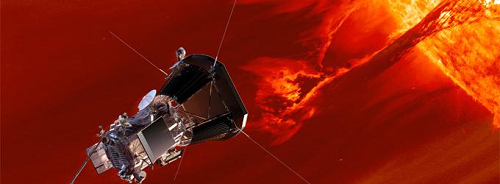Next Stop: A Trip Inside the Sun's Atmosphere
Every so often the sun emits an explosive burst of charged particles that makes its way to Earth and often wreaks havoc on power grids, aircraft and satellite systems. When clouds of high-speed charged particles come racing off the sun, they can bathe spacecraft, astronauts and planetary surfaces in damaging radiation. Understanding why the sun occasionally emits these high-energy particles can help scientists predict space weather. Knowing when solar energetic particles may hit Earth can help people on the planet take precautions.

Now, Draper and the Smithsonian Astrophysical Observatory (SAO) are addressing these challenges, and hoping to untangle these unsolved science mysteries, by developing sophisticated sensors for a new NASA mission. Launching in 2018, NASA's Solar Probe Plus spacecraft, which is being designed and built by the Johns Hopkins University Applied Physics Laboratory in Laurel, Md., will make 24 solar flybys over nearly seven years, setting a new record for the fastest moving man-made object as it zips 37.6 million kilometers closer to the sun than any spacecraft that has ever studied this star, and be exposed to temperatures exceeding 2500 degrees Fahrenheit.
NASA's Solar Probe Plus—the first mission that will fly into the sun's upper atmosphere and "touch" the sun—will collect data on the mechanisms that heat the corona and accelerate the solar wind, a constant flow of charged particles from the sun. These are two processes with fundamental roles in the complex interconnected system linking the sun and near-Earth space—a system that can drive changes in our space weather and impact our satellites.
To capture the velocity and direction of the positively-charged particles, Solar Probe Plus will be equipped with a Faraday cup, built by the Smithsonian Astrophysical Observatory, with technical support from Draper, and operated by SAO and the University of Michigan in Ann Arbor. The Faraday cup, which is capable of measuring the full force of supersonic solar particles and radiation, is one of only two instruments riding outside the protective sunshield of NASA's Solar Probe Plus. The challenge will be to capture the data while operating at extreme temperatures on the fastest moving manmade spacecraft ever created—it will achieve a velocity of close to 200 km/sec—and do it with accuracy.
For years, astronomers have studied the sun, but never from inside the sun's atmosphere, according to Seamus Tuohy, Director of the Space Systems Program Office at Draper. "Such a mission would require a spacecraft and instrumentation capable of withstanding extremes of radiation, high velocity travel and the harsh solar condition—and that is the kind of program deeply familiar to Draper and the Smithsonian Astrophysical Observatory."
The investigation will specifically track the most abundant particles in the solar atmosphere and wind—electrons, protons and helium ions--"in addition to answering fundamental science questions, the intent is to better understand the risks space weather poses to the modern communication, aviation and energy systems we all rely on," said Justin C. Kasper, principal investigator at the Smithsonian Astrophysical Observatory and University of Michigan Professor in Space Science. "Many of the systems we in the modern world rely on—our telecommunications, GPS, satellites and power grids—could be disrupted for an extended period of time if a large solar storm were to happen today. Solar Probe Plus will help us predict and manage the impact of space weather on society."
Draper
At Draper, we believe exciting things happen when new capabilities are imagined and created. Whether formulating a concept and developing each component to achieve a field-ready prototype or combining existing technologies in new ways, Draper engineers apply multidisciplinary approaches that deliver new capabilities to customers. As a not-for-profit research and development company, Draper focuses on the design, development and deployment of advanced technological solutions for the world¹s most challenging and important problems. We provide engineering solutions directly to government, industry and academia; work on teams as prime contractor or subcontractor; and participate as a collaborator in consortia. We provide unbiased assessments of technology or systems designed or recommended by other organizations—custom designed, as well as commercial-off-the-shelf.
Source: Harvard-Smithsonian Center for Astrophysics
- 366 reads
Human Rights
Ringing FOWPAL’s Peace Bell for the World:Nobel Peace Prize Laureates’ Visions and Actions

Protecting the World’s Cultural Diversity for a Sustainable Future

The Peace Bell Resonates at the 27th Eurasian Economic Summit

Declaration of World Day of the Power of Hope Endorsed by People in 158 Nations

Puppet Show I International Friendship Day 2020

